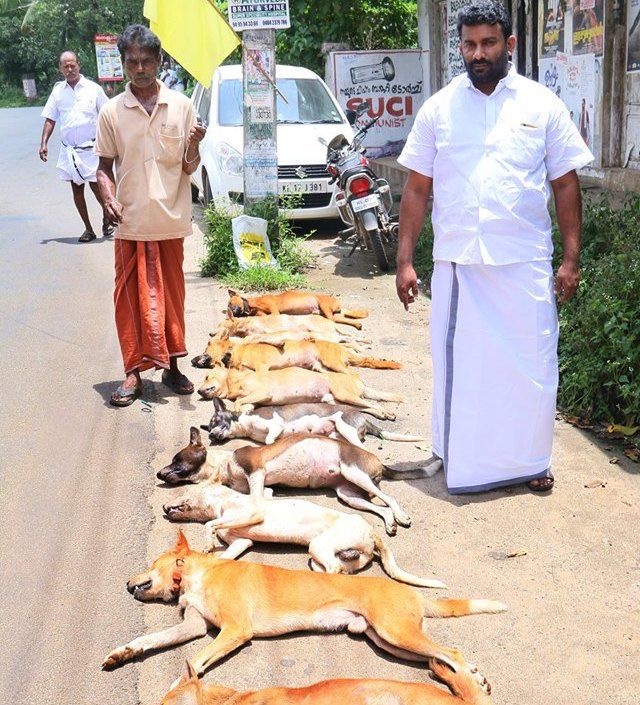IndiaWilds Newsletter Vol. 8 Issue XII
Street Dogs: People & Wildlife
 A four-year-old boy, was recently mauled to death by a pack of street dogs at 10 am in the morning in Puri, Odisha. The boy had asked his mom to let him go for flying kites. His aunt was nearby when the incident happened. Last month a 15 year old girl died after falling into a well while fleeing from street dogs in Kadangodu near Wadakkanchery in Kerala. These two incidents, even though ghastly may appear to be isolated incidents reported from East and South of India. However, it is not.
A four-year-old boy, was recently mauled to death by a pack of street dogs at 10 am in the morning in Puri, Odisha. The boy had asked his mom to let him go for flying kites. His aunt was nearby when the incident happened. Last month a 15 year old girl died after falling into a well while fleeing from street dogs in Kadangodu near Wadakkanchery in Kerala. These two incidents, even though ghastly may appear to be isolated incidents reported from East and South of India. However, it is not.
In June 2016, a 10-year-old girl was ripped apart by street dogs in Madhya Pradesh’s Khargone district. In January 2016, a teacher was killed by street dogs in Bareilly in Uttar Pradesh. August 2015 saw the death of a six year old boy in Jamia Nagar in New Delhi and again the culprit were a pack of street dogs. There are many such incidents of street dogs mauling people, chasing motorists, devouring newborn babies in hospitals and running amok unleashing a reign of terror.
In Kerala, the situation has reached to such heights that the Hon’ble Supreme Court has appointed a Committee headed by Retired High Court Judge Justice Siri Jagan to study the menace of street dogs, find out reasons for deaths, availability of anti-rabies vaccines in hospitals and related issues.
The Committee has compiled a list of dog bite incidents in Kerala and has found that the maximum number of dog bites numbering 5948 have happened in Thiruvananthapuram district. Palakkad is second with 4916 cases of dog bites, followed by Kollam at 3670, Alappuzha at 2967, Pathanamthitta at 2,892, Ernakulam at 2,050, Thrissur at 2,044 and Kottayam with 1614 cases of dog bites. The stray dog population in Kerala is estimated at 2,68,994.
In Kerala, now there are vigilante groups prowling the streets to hunt street dogs. The Old Students Welfare Association of St Thomas College in Pala, Kerala has said that a “gift” would be given to the heads of panchayats and municipalities across the state where most stray dogs are killed. Its secretary James Pambaykkal said “Those panchayat presidents who lead killing of maximum number of stray dogs will be rewarded with gold coins from our side. They have a months time to win and get the gold coin.”
There were other groups that openly paraded bodies of street dogs in processions. Predictably these incidents resulted in a few petitions in the Apex Court and finally the Hon’ble Supreme Court had to intervene and ordered Kerala Government to take action against vigilante groups for killing street dogs.

Politician posing with dead street dogs in Kerala Courtesy – online media
Nevertheless, the Supreme Court bench comprising Justices Dipak Misra and U U Lalit said that “Compassion should be shown towards stray dogs but at the mean time, these animals cannot be allowed to become a menace to the society. A balance needs to be created for dealing with such situation”.
Unfortunately, like everything else, people as well as the Hon’ble Supreme Court are failing to understand the core issue. Dog bites is just a symptom of a deeper malaise afflicting our society.
Love Without Responsibility:
Many of us are dog lovers and don’t mind throwing a scrap or two looking at the wagging tail of a street dog. It fills us with joy. Unfortunately, feeding street dogs also results in their numbers increasing. The Animal Welfare board of India in its February 2015 circular says “those who feed street dogs are advised to participate in their sterilization, and yearly vaccination too, since they win the trust of the dogs through feeding them. They are also advised to provide, or to assist animal welfare organizations in providing health care to them.”
However, as is always the case, we Indians are more conscious about our rights but never care to fulfil our responsibilities. So we never spare a thought about helping sterilise the street dog that we may be feeding. This small act by us also results in increasing the street dog population.
Birth control of pets, irresponsible ownership
We rarely focus on reducing the number of owned dogs. There are many times when the pets are abandoned or pets mate with street dogs and the offspring is abandoned. One can often find dogs with collars roaming in the countryside and they become a threat to people as well as other species. The authorities never focus on sterilising the pets. As long as there are pets and they don’t’ come under birth control, the street dog population will not come down.
Sterilisation: Not the panacea of all Dog problems
The municipal authorities don’t sterilise the dogs because it is a costly affair to cover all the dogs. Some officials say that the cost per dog can go upto 4000 rupees. And in suburban areas where the dogs roam around in a large area which can at times be inaccessible catching dogs for sterilisation would be a big challenge. In places like Thane creek catching the dogs is tough because the street dogs move into the creek and hunt for crabs, birds and even injured flamingos.
Even if we sterilise dogs in an area and release them in the same area, when these sterilised dogs die, dogs from other surrounding areas will simply move in and repopulate that area. So there will always be constant influx of dogs into an area. Since the authorities would have sterilised the area once, they will not come back to that area for re-sterilisation and won’t know that new dogs have come in the place of sterilised dogs.
Sterilisation of dogs may meet the Animal Welfare Board guidelines, they may immediately not become a problem to humans but they will continue to be problem for other wildlife species.
Street Dogs hunting Wildlife
We are aware of many incidents of street dogs hunting spotted deers around Bandhavgarh National Park, Keoladeo Ghana National Park in Bharatpur, Sanjay Gandhi National Park and Bhimashankar in Maharashtra and this issue occurs on the outskirts of virtually every national park or wilderness areas in India. 20 spotted deer deaths by free-ranging packs of stray dogs in the first three months of 2016 have been reported from University of Hyderabad campus (TOI)
According to a July 2010 report in the Hindu. The Indian Gazelle population in Jodhpur is facing significant threat from stray dogs. A July 2016 report in Business Standard suggests that the problem continues.
The feral dogs also cause great damage to ground nesting birds, flamingoes, Olive Ridley turtles and many other wildlife species.
The deleterious impact of dogs is not only limited to herbivores and birds, they also negatively impact other carnivores. A study titled “Interference Competition at the landscape level: the effect of free-ranging dogs on a native mesocarnivore” (Vanak et al, 2010, Journal of Applied Ecology)
concluded “the presence of domestic dogs on the periphery of natural habitats can interfere with the spatial distribution of a sympatric carnivore. Vaccination and sterilization programmes, aimed at reducing population sizes and pathogen prevalence, do not restrict the free-ranging behaviour of dogs. Therefore, in areas of conservation value, control of free-ranging dogs would be required to fully mitigate the deleterious effects of dogs on native carnivores and other wildlife.”

Free ranging dog feeding on carcass with jackal in the background
Street Dogs & Disease Transmission to Wildlife
Apart from hunting wildlife, the street dogs also transmit diseases to wild animals. Multiple studies have concluded that pathogen spill over from dogs is a significant threat to wild carnivore populations (Funk et al. 2001; Cleaveland et al. 2007). Canine Distemper Virus (CDV) transmitted from dogs had killed more than 1000 lions out of a population of 3000 lions, as well as other carnivores like leopards and hyenas in Serengeti in 1994. Canine parvovirus (CPV-2) is believed to be the reason behind the crash of wolf population in Isle Royale National Park, Michigan in 1981-1982 (Peterson et al. 1998, Journal of Mammalogy).
A 2013 study titled “Canine distemper virus: an emerging disease in wild endangered Amur tigers (Panthera tigris altaica)” (Seimon TA, Miquelle DG, Chang TY, Newton AL, Korotkova I, Ivanchuk G, Lyubchenko E, Tupikov A, Slabe E, McAloose D. 2013, mBio) summarises that the canine distemper virus (CDV), “the second most common cause of infectious disease death in domestic dogs and a viral disease of global importance in common and endangered carnivores, as the etiology of neurologic disease and fatal encephalitis in wild, endangered Amur tigers. We establish that in 2010 CDV directly or indirectly killed ~1% of Amur tigers”.
In 2013, Canine Distemper Virus had killed atleast four tigers in India following which the National Tiger Conservation Authority (NTCA) issued an urgent directive to tiger reserves recommending vaccination of dogs around these protected areas. All tiger carcass found in the wild were to be tested for virus. It is not known to what extent these recommendations were implemented and whether any vaccination efforts were carried out around the National Parks and protected areas.
With the increase in free-ranging dog population, dogs are found to be indulging in scavenging from even tiger kills. When dogs and other wild animals feed from the same kills one after the other, disease transmission can happen to the wild carnivores. The dogs dominate over other smaller carnivores who wait for their turn to feed from the kills and are more likely to get the disease transmitted from dogs.
Personally I have seen mange in jackals in Keoladeo Ghana National Park where dogs from the surrounding villages are always scavenging for food or looking for opportunity to hunt deers and co-exist with jackals, hyenas and smaller carnivores like jungle cats etc.
Collapse of Garbage Collection
In most of the cities and towns in India garbage disposal has become a rare thing. The civic authorities don’t take their roles seriously and garbage is dumped in any vacant site.
There are large corporates who throw the food waste from their canteens. These runs into hundreds of kgs. Large offices generate a minimum of 200-300 kgs of food waste per shift. Without adequate methods to dispose waste, these food waste is dumped in far off sites and the street dogs get regular supply to multiply their numbers rapidly.
The people too believe that it is only the responsibility of the civic authorities to clear garbage and hence they litter in the most irresponsible manner. There was a time when littering was socially not acceptable.

Sean Connery in Untouchables
In the film Untouchables, which is based in 1930s America, Sean Connery playing the role of a beat police officer admonishes Kevin Costner for throwing a paper in the river while standing on top of a bridge. He says “throw it in the goddamn trash basket”.
Unfortunately, we have lost the habit of disposing our waste in a responsible manner. Neither we have responsible officers to prevent littering, nor are we prosecuted for littering. So we see the sight of people nonchalantly rolling downt their car windows and throwing the empty wafter packets in the streets.
Apart from making our beautiful country look filthy, this also results in scavengers finding enough food from the undisposed garbage.
There was a time when the word scavengers used to denote species like vultures, jackals, hyaenas etc. In India today, both in urban as well as in rural areas, the scavengers that are on top of the chain are street dogs.
The street dogs are the ones that scare away jackals, vultures etc and eat the dead animals as well as discarded food items. As a result the street dog species multiply. Man may have domesticated dog a long time ago. However, when left to fend for themselves, the wild instincts of the dogs take over and they start hunting in packs chasing and mauling people, livestock as well as wild animals.
Simply catching dogs and killing them will not solve the problem. The moment the vigilante groups slack in their efforts, the dog population will again increase because dogs don’t have a specific breeding season and they can multiply pretty fast if enough food is available for them.
This problem is our creation and we have to solve it in a humane manner. Citizens along with the municipal authorities have to sort out the garbage collection and disposal mechanism and ensure that there is no littering. Simultaneously we have to start sterilising the street dogs. This will over a period of time help in reducing their population.
If we have to wage a war, then it is better to wage a war against our own habit of generating huge amounts of waste and then dumping it outside.
Pope Francis takes on the GMO Lobby
Pope Francis, revered by millions of practicing Christians worldwide has also earned respects of people of other faiths when he stood up to fight climate change by releasing an Encyclical in 2015. Though the Pope Francis had asked, he had narrowly focussed on the impact of GM crops from a human health, human exploitation and losses of small producers. He had however asked for a comprehensive approach to examine the GM crops issue and had said that complete information about Genetically modified crops are intentionally not put on the table. ( Read more in : http://www.indiawilds.com/diary/indiawilds-newsletter-vol-7-issue-vi/) .
However, this time Pope Francis has specifically raised the issue of Genetically Modified crops by writing a letter to the Director General of FAO (Food and Agricultural Organisation).
Pope Francis has pointed out the limitations of lab results by saying that “Producing qualities that may give excellent results in the laboratory may be advantageous for some, but have ruinous effects for others. And the principle of caution is not enough, as very often it is limited to not allowing something to be done, whereas there is a need to act in a balanced and honest way. Genetic selection of a quality of plant may produce impressive results in terms of yield, but have we considered the terrain that loses its productive capacity, farmers who no longer have pasture for their livestock, and water resources that become unusable? And above all, do we ask if and to what extent we contribute to altering the climate?”
It is a known fact that the GM lobby only talks about higher yield of the GM crops to push for its adoption. However, they don’t mention that the pests develop crop resistance after a few years. Recently Monsanto was forced to admit that in Amreli, Bhavnagar, Junagarh and Rajkot districts of Gujarat, the pink bollworm pests have developed resistance to the BT Cotton. So Monsanto wants the farmers to shift to its next generation of seeds for which the insects haven’t developed resistance and also it wants the farmers to plant non-BT Crop as refuges around the BT Crop so that the so called refuges would attract the insects. This will also reduce the acreage under cultivation for cotton. This is what scientists have been predicting all along that the Genetically modified crops will result in developing resistance in the pests and then there will be nowhere to go. (Ref: Monsanto’s Audacity, IndiaWilds Newsletter Vol. 8 Issue VIII : http://www.indiawilds.com/diary/indiawilds-newsletter-vol-8-issue-viii/ )
Pope Francis has raised the issue of Genetically modifying organisms in nature and has said “In the sector in which the FAO works, there is a growing number of people who believe they are omnipotent, or able to ignore the cycles of the seasons and to improperly modify the various animal and plant species, leading to the loss of variety that, if it exists in nature, has and must have its role.” Apart from pest resistance, scientists have also pointed out the threat to the biodiversity due to the GM crop gene escaping into the wild. (The Potential for crop to wild hybridization in egg plant in Southern India, Davidar et al. 2015, American Journal of Botany). With the genes from the BT crops being able to hybridize wild plants, GM crops have a huge impact on our bio-diversity.
George Schaller while writing on the chapter Rainforests had this to say, which is also applicable to other ecosystems:
“we can plant trees but cannot re-create the original forest. Ecological processes are so complicated that planted forests are only superficial replicas…. We still know too little to manipulate forests and predict the consequences.… An intriguing aspect of rainforest life is its extraordinary mutualism, a dependence of organism upon each other. For instance, each of the many fig species has its own wasp pollinators. A rainforest is remarkably complex, yet its stability is tenuous. The extinction of a pollinator or seed disperser may cause the death of a plant species and with it many other species, especially invertebrates, which depend on it. Such responses are subtle and perhaps long delayed. How many key species can a rainforest lose before order becomes chaos, before the community collapses in an avalanche of extinctions?”
It would be pertinent to keep in mind that in Nature, there is a complex web of inter-relationships between various species and loss of one species, however small it may be in size, can result in significant challenges towards the survival of human species on this planet earth. Today we are still discovering new species. Science hasn’t been able to unravel the intricate relationship between each species. So when we modify a plant species, we do it at our own risk as we don’t knowledge about how the ecosystem would be impacted by changing one part of it. So Pope Francis is right when he points out fallacy of pushing for adoption of GMO crops simply on the basis of laboratory results.
The Pope further points out the limitations of science as millions still go hungry despite our so called scientific farming, food storage and related technological developments. He says “Not precaution, then, but wisdom: what peasants, fisherman and farmers conserve in memory handed down through the generations and which is now derided and forgotten by a model of production that is entirely to the advantage of a limited group and a tiny portion of the world population. Let us remember that it is a model which, despite all its science, allows around eight hundred million people to continue to go hungry.”
According to a FAO study (The Food Wastage Footprint Impacts on Natural Resources, 2013), ( Read more details in : http://www.indiawilds.com/diary/indiawilds-newsletter-vol-5-issue-ix/ ) about one third of worlds food production is wasted. This amounts to 1.3 billion tons of food wasted a year. Apart from the damage to environment, this is a criminal wastage when eight hundred million people are starving.
So Pope Francis has highlighted this issue in his letter to FAO by writing “we have reiterated that the level of world production is sufficient to ensure food for all, provided that distribution is equitable. But can we still continue along this line, if market logic follows other routes, to the point of making food products a commodity like any other, to use produce increasingly for non-food uses, or to destroy food for the simple fact that there is excess in relation to profit and not to need? Indeed, we know that the mechanism of distribution remains theoretical if the hungry do not have effective access to foodstuffs, and if they continue to depend upon more or less conditional external support, if the correct relationship is not established between need and consumption, and not least, if waste is not eliminated and food loss is not reduced.”
Since one third of the food produced ie 1.3 billion tons is wasted, the main premise of GM lobby about the need to increase the productivity of crops by making them pest resistant becomes invalid. It is important to wage a war on waste by increasing awareness levels across all people, rich and poor, young and old, so that the food wastage becomes negligible in the near future. This can help us stay away from the toxic Genetically Modified crops.
Unfortunately, the GM lobby seems to have support in the present Indian Government at the Centre. In November 2016, India’s Minister of State for Environment, Forests and Climate Change Shri Anil Madhav Dave had in a written reply to a question raised in Lok Sabha has asserted that all concerns expressed by the public about the safety of GM Mustard has been adequately addressed. “Genetic Engineering Appraisal Committee (GEAC) and its sub-committees involve representatives of National Institute of Nutrition (NIN), Bio-Medical Group of Bhabha Atomic Research Centre (BARC), Ministry of Health and Indian Council of Medical Research (ICMR). All the members of GEAC and its sub-committees have been regularly and actively involved at several stages in the assessment of food safety of GM mustard.”
With many scientists world over bending infront of the powerful GMO lobby and many officials and journalists co-opted to peddle the claims and PR campaigns to promote Genetically Modified crops and vegetables, it is a tough challenge for a few well meaning individual scientists to oppose the powerful GMO lobby. If other influential religious leaders can raise their voice against GM crops like Pope Francis has done, then there may still be some hope that GM Crops don’t ravage our ecosystem as well as health of our people.
The complete letter of Pope Francis to the Director General of FAO is reproduced in the PDF. To read more check the below link:
Conservation News
Yamuna Bio-Diversity Leopard loses its Independence:
The leopard which was sighted in the Yamuna Bio-diversity park has now been trapped by the authorities despite protest by conservationists.

Yamuna bio Diversity park
Earlier fears were expressed that the local villagers may kill the leopard. So the authorities have trapped the leopard and shifted it to Delhi Zoo for tests. The Chief Wildlife Warden of Delhi A K Shukla said the leopard “will be medically tested which is a prerequisite before such animals are released in the wild. We will check whether it is fit to be released because it may have injured himself or may have contracted some infection…It is young and its family might be in Kalesar from where it has come trekking along the Yamuna. But we are in touch with authorities elsewhere also and will translocate it in the most appropriate location possibly in the next two days.”
Barking Deer Sighted in Yamuna Bio-diversity Park
It is said that when you leave a large enough space without much disturbance, nature will recolonize it and slowly start repopulating it. This is being proved in back to back cases in Yamuna bio-diversity park which is spread over 457 acres. In November 2016, a leopard was sighted in the Yamuna bio-diversity park. Now a barking deer has been sighted there.
The barking deer has been caught in the camera traps twice. This barking deer has been sighted in the Phase 2 of the park which has got moist deciduous vegetation. It is speculated that the barking deer probably first came to the Phase 1 of the park which has some links with Rajaji National Park and Kalesar National Park and then is now residing in the Phase 2 of Yamuna bio-diversity park. Barking deers have been locally exterminated in Delhi more than a couple of centuries ago. So this sighting is significant. This news should convince the Government to put more efforts into the Yamuna bio-diversity park.
The barking deer may be a female as its antlers were not visible in the camera traps. We hope more such barking deers repopulate the park soon.
Three Elephants mowed down by Train in Assam
Indian Railways continues with its elephant killing. This time the culprit was the 15905 UP Kanyakumari-Dibrugarh Vivek Express. The train hit the elephant herd between Kundulimari village and Santipur village on 4th December night at around 11:50 pm. The spot is near Jugijan railway station in Nagaon district and is about 137 kms from Guwahati railway station.
The three elephant dead bodies were found the next day morning. One of them was a small three year old elephant. The forest department has estimated the other two elephants to be of 13 and 15 years old. However, both these two elephants are said to be pregnant when they were cruelly mowed down by the train. Asian elephant males reach sexual maturity at between 10–15 years of age; females usually first give birth in years 15 or 16 (Shoshani and Eisenberg, 1982). So the dead elephants may be pregnant for the first time when they were killed by the speeding train.
The Chief Public Relations Officer (CPRO) of the Railways, Pranav Jyoti Sharma said that there were no train speed restrictions in the area. “This is the first time such an accident of train knocking down elephants happened at the location”. Trains continue to knock down elephants in key elephant corridors in Assam and in other states. No railway minister has ever taken any meaningful step to stop this problem from recurring.
The MoEF&CC too keeps quiet after such accidents, though elephants are protected and also have been declared as National Heritage Animal. Historically, the Railway Ministry is a much more coveted ministry than the environment ministry as the Railways minister can often dole out more jobs and contracts. So often the Railways minister is a Cabinet minister where as the Environment Minister is a Minister of State. Being a junior minister, the Environment Minister often shies away from any confrontation with their senior colleagues and elephants continue to be killed at an alarming level.
Elephants are classified as Endangered in the IUCN Red List and their population trend is decreasing. If we can stop this elephant killing by railways and secure their corridors as well as habitat and reduce human-elephant conflict, then the future of elephants can be secured. Else, the future looks bleak.
Tiger deaths shoot up 25% to 98 in 2016
Tiger deaths have shot up by 25% in 2016 and have reached 98 as per a written response to a Rajya Sabha question by Minister of State for MoEF&CC Shri Anil Madhav Dave. The 98 deaths of tigers is due to poaching as well as natural causes and in some cases the causes are still unclear and under investigation. This data had been compiled by NTCA (National Tiger Conservation Authority). Last year the number of tiger deaths were lower at 78.
Madhya Pradesh accounts for a large part of the tiger deaths as a total of 31 tiger mortality cases have been reported from there. There have been cases of tiger deaths due to politicians and those have never reached a successful conclusion. Once known for tigers, its share in total tiger population of India has decreased over the years and it is now behind Uttarakhand and Karnataka in tiger numbers.
The number of tiger deaths due to poaching has also doubled from 14 last year to 29 this year. Unless NTCA lists each cases of poaching, investigation process carried out and the action taken report in the public domain there won’t be much of pressure. These days one can track patrolling route by using even a smart phone. In many of the reserves patrolling is not done either due to lack of personnel, old age or simply due to focus on managing tourism. Tiger numbers will continue to flounder and poaching will remain unabated unless we accord protection, protect their habitat, use field intelligence to nab poachers and prosecute them.
Number of Tigers in different Tiger Range States based on tiger estimation in 2010 and 2014

Tiger estimation in 2010 and 2014
+From Scat DNA
♣ From camera trap data and scat DNA
* Much of the tiger occupied areas could not be surveyed owing to naxal problem
** Tiger estimation was not done in the year 2010
Adult Male Tiger Poisoned in Bandipur
A nine year old adult male tiger has been killed by poachers in Bandipur National Park on 19th December and its paws and teeth are missing. The body of the tiger was found by the forest department. The tiger is said to have been dead for three days. There were no visible injury marks on the body of the tiger. So it is expected that the tiger may have been killed by poisoning. The head and body parts of a calf was found which raises suspicion that the calf was poisoned and left behind for the tiger to consume it and get killed.
After the tiger had died of poisoning the poachers had cut off the paws and pulled out the teeth of the tiger. Unfortunately, apart from the tiger the poisoned carcass can also result in the death of other scavengers who consume the poisoned carcass.
The viscera of the tiger has been sent for forensic tests as per protocol and results are awaited.
Since the carcass of the tiger was discovered only after three days, it points out to the lack of adequate patrolling by the forest department. These days, the forest department is more concerned about managing tourists and projecting the tourism revenue to declare itself as a premier destination. The patrolling is not given any priority. NTCA has to ask proof of foot patrolling kilometres done by the reserve staff every month. Else, the poaching problem cannot be controlled.
National Green Tribunal stops MMRC from construction work in Aarey Colony
The National Green Tribunal has restrained Mumbai Metro Rail Corporation (MMRC) from undertaking any further construction work in the Aarey Milk Colony in Mumbai till further orders after an application was filed by the NGO Vanashakti citing the violation of prior NGT orders.
The NGO had stated that MMRC has started work in the Aarey milk colony near Jogeshwari Vikroli Link Road (JVLR) though NGT had ordered for status quo. Aarey Milk Colony is a huge green area and serves as a lungs for the Mumbai city. Over the years lot of settlers have settled in the Aarey Milk Colony and now the Mumbai Metro Rail Corporation wants to create a Metro car shed for the Metro III (Colaba to SEEPZ) project which will result in cutting of a lot of trees and destruction of the area. The Aarey Milk Colony has leopards residing in it for generations. With the destruction of the area, the human-leopard conflict is going to increase.
“The world is not dangerous because of those who do harm but because of those who look at it without doing anything”. – Albert Einstein
Equipment Discussions
Low Cost LED Lights for Photography & Filming
If you are a photographer or a videographer, then there are times when you badly needed a light directly on camera or even some fill light to light the product or talent from an angle or open up shadows in an area. The quality of the LED lighting has dramatically improved in the last four years and the cost has also come down. So sharing details of a couple of low cost LED lights which are good quality and can come in handy for your photography and filming needs.
Aputure Amaran M9 LED Light:
This is a new light launched this year by a company called Aputure. Photograpy buffs my feel that this is a misspelling of the Aperture, however, this is how the company is named.

Aputure Amaran M9
The Aputure Amaran M9 is a small LED light the size of a credit card. It is daylight balanced and can be kept in your shirt pocket. The colour temperature of this LED light is 5500K and it has a good CRI and TLCI rating of 95. The light also comes with a removable diffusion sheet and it has 9 steps of dimming to lower the light levels.
The Aputure Amaran M9 light is powered by an 1800 mAh lithium polymer battery and it can run for upto 2 hours at full power levels. The light can be charged through a USB port from your computer and it comes with a USB cable. USB charger though is not included in the kit. However, these days with many of the smart phones coming with removable USB chargers, one can easily use the USB cable on those chargers as well.
The Aputure Amaran M9 gives you ≥80 lux at 1 meters and ≥900 lux at 1 feet.
The diffusion, CTO and CTB filters can be attached magnetically to the M9 light. The CTO filter can lower the colour temperature of the M9 light to 3400K and the CTB filter can raise the colour temperature to around 8800K. The light can be mounted on an adapter and mounted on the cold shoe of the camera.
The Aputure Amaran M9 light weighs only 140g.
Cost: The Aputure Amaran M9 light costs 45 US dollars.
I like this light because of its extreme portability and ability to easily use it offcamera. The light can be bought from B&H at this link: http://www.bhphotovideo.com/c/buy/Aputure_Amaran_M9/Ntt/Aputure%2BAmaran%2BM9/N/0/kw/search/BI/19990/KBID/13252/DFF/d10-v1-t12
Unfortunately, the light is not yet available in Amazon India.
Aputure Amaran AL-H160 on camera light
If you have a situation where you need a bit more brightness then what the tiny Aputure Amaran M9 can produce, then there is the Amaran AL-H160 which is similarly priced LED light but with a bigger throw.
And the good thing is it is also available in India at Rs. 5499/- in Amazon India.
It gives you 5500K colour temperature ie it is daylight balanced and has a high colour rendering index CRI 95+ and you can dim it when needed. So for still photographers this can be a big help as they can control the light instead of flashing and burning the highlights. You an use 6 AA batteries or Sony batteries.

Aputure Amaran Al-H160
There are 160 LEDs in this light and its beam angle is 60 degrees. The interesting thing is there are expansion slots for connecting upto 9 lights for creating a large source. Of course, if I would need a large source then I would use my Area 48 BBS plasma light. Nevertheless, having option to attach additional lights is very helpful in many situations as it increases your flexibility.
The Aputure Amaran M9 gives you ≥80 lux at 1 meters and ≥900 lux at 1 feet.
In comparison the Aputure Amaran Amaran AL-H160 gives you 750 lux at 1 meters ie. 3.3 feet away. So this light is about 9 times brighter.
At 2 meters the Amaran AL-H160 gives you 210 lux.
The weight of this LED light is 325 gms. It can be mounted on your camera as well as on lightstands.
The lighting technology has improved so much in the last few years that it is unbelievable. Nearly four years ago I had bought the Litepanels MicroPro On-Camera LED light for camera top mouting at 315 US dollars. Now the Aputure Amaran AL-H160 is available only at 40 US dollars in B&H
It is also available in Amazon India at the following link:
Open Letter to Camera Manufacturers to build Encryption into cameras
About 150 filmmakers, photojournalists, documentary shooters and freelancers have written an open letter to various camera manufacturers like Canon, Nikon etc to ask them to build encryption into the cameras.
At present if you have shot an important documentary or news using a camera and the camera or the memory card is stolen, robbed or even confiscated by say security guards, opponents or even Government forces, then they can access your footage. In news worthy events or exposes it can lead to even exposing your news sources and putting their lives in danger.
Following is the full text of the letter published by the Freedom of the Press Foundation:
December 14, 2016
Public Relations Department
Corporate Communications Division
Canon,
One Canon Park,
Melville, NY 11747
Dear Canon,
We, the undersigned documentary filmmakers and photojournalists, are writing to urge your company to build encryption features into your still photo and video camera products. These features, which are currently missing from all commercial cameras on the market, are needed to protect our safety and security, as well as that of our sources and subjects worldwide.
Without encryption capabilities, photographs and footage that we take can be examined and searched by the police, military, and border agents in countries where we operate and travel, and the consequences can be dire.
We work in some of the most dangerous parts of the world, often attempting to uncover wrongdoing in the interests of justice. On countless occasions, filmmakers and photojournalists have seen their footage seized by authoritarian governments or criminals all over the world. Because the contents of their cameras are not and cannot be encrypted, there is no way to protect any of the footage once it has been taken. This puts ourselves, our sources, and our work at risk.
Many technology companies have in recent years embraced encryption technology, often including it in their products and enabling it by default. Indeed, encryption has, in some sectors, become an industry-best practice. Apple’s iPhones encrypt all data stored on them by default, as do many phones running Google’s Android operating system; text messages and voice calls made with WhatsApp, iMessage, FaceTime, and Signal are all protected using end-to-end encryption technology; and laptops and desktop computers running modern versions of Microsoft Windows and macOS encrypt all data stored by default too.
However, we face a critical gap between the moment we shoot our footage and the first opportunity to get that footage onto more secure devices.
As filmmakers and photojournalists who value our own safety and the safety of our sources and subjects, we would seek out and buy cameras that come with built-in encryption. Adding these data security features to your product line would give your company a significant competitive advantage over other camera manufacturers, none of whom currently offer this feature.
Beyond the commercial motivation for adding encryption features, we know your company has commendably committed to corporate social responsibility. Building encryption into your products is not just about helping the filmmakers and photojournalists who buy them, but about making the world a better place. As filmmakers and photojournalists, we use our lenses to hold powerful people to account — and ultimately to change society for the better. Encryption features will allow us to continue to tell the most important stories, from some of the most dangerous places in the world.
You can help us reach that goal by starting to work towards building encryption into your camera products.
Thank you for your consideration.
Signed,
Over 150 Filmmakers, Photographers, and Media Workers Around the World
The original letter can be found here: https://www.documentcloud.org/documents/3238288-Camera-Encryption-Letter.html
Super Dark Variable ND Filter from Syrp
Syrp has introduced a new super dark ND filter which has a 5 to 10 stops of adjustable exposure control. This is achieved by a smooth adjustable front ring. It has hard stops at each end to indicate maximum and minimum ND effects.
This filter has front threads for stacking filters and it comes in two kit sizes. The Large Filter Kit has 82mm filter and it has step up rings of 77-82 and 72-82mm. So if you have a 77mm filter mount like a Canon EF 70-200 f2.8 L IS II lens, then you can first mount the step-up ring 77-82mm infront of the lens and then attach the 82mm filter.
Similarly, the Small filter kit has got 67mm filter and has got step up rings of 58-67 and 52-67mm.
The filter kit consists of genuine leather case, two lens step-up adapter rings and a lens cloth. The smaller kit cost is 169 USD and the Large filter kit costs 209 US dollars.
The Syrp Super dark Variable ND filter kits can be ordered from B&H link: http://www.bhphotovideo.com/c/buy/Syrp_super_dark_variable_ND/Ntt/Syrp%2Bsuper%2Bdark%2Bvariable%2BND/N/0/kw/search/BI/19990/KBID/13252/DFF/d10-v1-t12
Natural History
COUNTRY NOTEBOOK: M. Krishnan: ‘The Arboreal Life‘ By Saktipada Panigrahi
http://www.indiawilds.com/forums/showthread.php?8852-Country-notebook-m-krishnan&p=81589#post81589
Wildlife Photography
Indian Fox by Subhash Shrivastava
http://www.indiawilds.com/forums/showthread.php?17886-Indian-fox-in-Kamathana
Gaur by Shyamala Kumar
http://www.indiawilds.com/forums/showthread.php?17904-Indian-Gaur
Eurasian Tree Sparrow by Samrat Sarkar
http://www.indiawilds.com/forums/showthread.php?17923-Eurasian-Tree-Sparrow_Manas-NP
Malabar Pied Hornbill – female by Uday Kiran
http://www.indiawilds.com/forums/showthread.php?17930-Malabar-Pied-Hornbill-female
Shaheen Falcon by Sandipan Ghosh
http://www.indiawilds.com/forums/showthread.php?17925-Shaheen-Falcon
Blue Throat Male by Joydip Mukherjee
http://www.indiawilds.com/forums/showthread.php?17896-Bluethroat-(-Male-)
Garden Lizard by Anil Kumar Verma
http://www.indiawilds.com/forums/showthread.php?17882-Dragon-Eye-Garden-Lizard-Portrait
Monitor Lizard by Jerin Dinesh
http://www.indiawilds.com/forums/showthread.php?17887-Monitor-lizard
Crab spider with Katydid catch by Prajwal Ullal
http://www.indiawilds.com/forums/showthread.php?17951-An-interesting-sight
Grasshopper by Arun Acharjee
http://www.indiawilds.com/forums/showthread.php?17928-Grasshopper
Painted Grasshopper by Dheerendra Singh
http://www.indiawilds.com/forums/showthread.php?17907-say-Hii-(painted-grasshopper)
With this issue of IndiaWilds we complete 8 years of uninterrupted publication of this journal which started as a newsletter and continues to evolve. I look forward to your inputs and support in preserving the last tracts of wilderness and wildlife left in our beautiful country and raising awareness about it. For other interesting articles and images check –http://www.indi
To post in the IndiaWilds forums, you can register free of cost using your Full Name as user id at:
http://www.indiawilds.com/forums/register.php
If you are already a member of IndiaWilds and have forgotten your user id and/or password you can mail to:
administrator@indiawilds.com
If you want to contribute original articles, or for any image enquiries please send a mail to:
administrator@indiawilds.com
Regards,
Sabyasachi Patra
Profile | Contact Us | Facebook | Diary | Equipment reviews | Forums | IndiaWilds You Tube Channel
Please post your views and feedback in the comments below.
- GoPro Hero 12 Black - 6 September,2023
- Leopards: The Last Stand - 2 July,2023
- Drifting in the Waters of Sundarbans - 26 March,2023









Your observations on stray dogs are astute. Not far from where I live there is a lady who feeds a pack of stray dogs with biscuits for ‘religious’ regions (to appease Rahu), but that is the only relationship between the pack and their benefactor. On the first of January this year, the pack had a small girl down on the road and almost all of them had bitten her at least once. I was off to buy the daily packets of milk when I saw that happening; the only weapon I had was the tote bag with two liters of packaged milk. Althoguh I did manage to rescue the girl, I cannot forget the look in the eyes of the dogs as I battled them to let her go, feral is the word that comes to my mind. The girl has now recovered, the dogs have marked me a permanent enemy —I have started carrying a hockey stick of late, but the woman is still feeding them biscuits. My only crib is the pack is staying in the vicinity because of the foolish woman.
I am also worried about GM crops. I hope nothing untoward happens to the food chain because of the genetic tinkering.
Dear Umashankar,
I am stunned to hear about the little girl being mauled and that finally you could save her. Earlier this year a pack of dogs came running when I was shooting in the night in a park in Delhi. I was testing the new Canon Cinema C300 Mark II camera and didn’t have anything else in my hand. Not even a tripod. Fortunately, I can claim to know a little bit of animal behaviour and things became ok. I used the camera to keep the dogs not coming close to me. May be I should share the video and explain the behaviour so that it will help people.
Cheers,
Sabyasachi
Do share the video, Sabyasachi, I’d appreciate the knowledge. Your videos are always a treat. Given that it was taken in a circumstance like that, I can’t wait to watch it. As it happens, I have had way too many encounters with stray dogs, none of my own choosing. On the other hand, my pet dog saved me from a cobra as a child.
The barking deer sighted in the Yamuna Biodiversity Park is likely a female hog deer. They inhabit the banks of the Yamuna in sporadic patches… I have seen them in Dadri area of Noida/ UP.